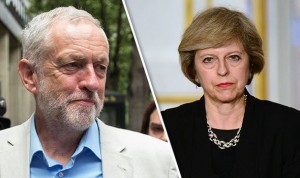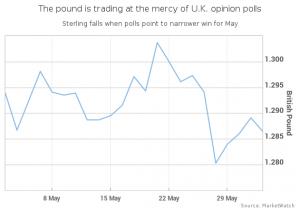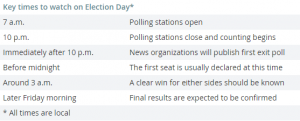Here we go again: Brits are headed to the polls for another crucial vote, less than a year after the Brexit referendum.
U.K voters will cast their ballots on Thursday, June 8, in a “snap,” or out-of-cycle, general election called by Prime Minister Theresa May, the leader of the Conservative Party, just seven weeks ago.
At stake is which party will guide the U.K. through the upcoming divorce negotiations with Brussels, which are set to be tough and which can be expected to define the country for generations to come.
May argues only she can provide the “strong and stable” leadership needed to secure a satisfactory exit from the European Union. In opposition, Labour Party leader Jeremy Corbyn promises a different tack to May’s “reckless” approach to Brexit, which has been a divisive process for the country.
Until recently, it looked as if May’s Tories were headed for a landslide victory. But support has diminished after some policy and campaign missteps. Opinion polls now point to a significantly tighter race than predicted between the two key parties, with the Liberal Democrats, the Green Party, the Scottish National Party and others all potentially having a role to play.
With just days until the ballot, here are the key things to know about the general election:
1. Why is the U.K. having an election now?
The U.K. wasn’t scheduled to hold a general election until 2020, as the rules require a vote to be held every five years. The last parliamentary election was held in May 2015, when the Conservative Party won a surprise majority and confirmed David Cameron as prime minister for another term.
Cameron had promised to hold a referendum on the U.K.’s membership of the EU if his party was returned to government, even though he preferred that Britain remain in the union. The referendum was held in June last year, and Cameron resigned immediately after it became clear, stunning as it was, that a majority of voters supported withdrawal.
Enter then–Home Secretary Theresa May. After taking over as Conservative Party leader, and thus as prime minister, she quickly quelled speculation that she would call a snap election to solidify her position. However, in April this year, when the Tories were enjoying almost record support in the opinion polls, she called an election for June.
May said she had made the move because opposition from lawmakers threatened to jeopardize the government’s plans for the so-called Brexit. The vote would deliver a more united Parliament and strengthen the U.K.’s negotiating stance with Brussels.
In essence, May was betting that the Tories would increase their slim majority of 17 seats in the House of Commons for a more commanding tally. That would reduce her dependence on backing from members of parliament who want a sharper break from the EU — more of a “hard Brexit” — than she does.
2. Who will win?
What had looked set to be a dull and predictable race has in recent weeks turned into something less than a sure thing.
Going by the opinion polls, May is still on track to win, but probably not by the landslide she was hoping for. According to the Telegraph’s poll tracker, the Conservatives are currently seven percentage points ahead of Labour — a far cry from the more than 20-percentage-point lead the Tories enjoyed when the election was first called.
A constituency-by-constituency model put together by pollster YouGov even projected the Tories could lose 20 seats and wave goodbye to their parliamentary majority. (Unlike a poll, the YouGov modeling tries to replicate the makeup of voters in electoral districts, and is the same process used by YouGov in its successful prediction of the Brexit vote.)
The plunge in support for the Conservatives came after the party released its manifesto. This included a policy — dubbed a “dementia tax” — under which elderly people might be obliged to sell their homes to pay for social care currently funded by taxpayers.
”[The] sharp recent reduction in the [Conservative] party’s lead, poor poll reliability in past votes, plus an unusually high level of uncertainty about the key issues and how different groups could vote, make this election tricky to call,” said Kallum Pickering, senior U.K. economist at Berenberg.
“To put it one way, we would not be very surprised if there was surprise,” he said in his note.
3. What will the outcome mean for the Brexit talks?
May has framed this as a one-issue election, where the overriding theme is who’s going to steer the U.K. through its EU divorce.
A strong showing for the Tories would strengthen May’s hand in negotiations with Brussels later this summer. Critics have said May has no electoral mandate to pursue her plan for Brexit, as neither she as potential leader nor the plan has ever been put in front of voters — both were adopted after Cameron stood down. May’s break-up plan is seen as very different from the vision put forward by Brexiteers in last summer’s referendum.
But if she wins, the prime minister will have been given a clear mandate from the public to pursue her Brexit vision, making it more difficult for the opposition to obstruct her.
A large Tory majority is also seen as diluting some of the influence of the “eurosceptic” party members that are pushing for a so-called hard Brexit. If May wins, however, there’s very little chance the U.K. will maintain access to the EU’s single market.
Labour, on the other hand, has vowed to retain the benefits of the single market and customs union. That is likely to mean a softer Brexit, where the U.K. keeps tariff-free trade with countries in the bloc in exchange for a softer stance on immigration. Labour leader Jeremy Corbyn, however, has been criticized for not wishing to take a tough stand in the coming discussions.
4. What will the election mean for the pound?
Recent action in the pound GBPUSD, -0.0929% has shown it trades at the mercy of the opinion polls ahead of the big day. And for good reason. The result of the vote could easily dictate sterling’s fate in coming months and send it either sharply higher or lower, according to analysts.
If the Conservatives win a majority, the pound is likely to regain some recently lost territory. That’s because more seats for May party’s could mean a better exit package with the EU and more clarity.
“Her stance on Brexit is more or less known, and the market will see her win as ‘business as usual,’” said Rahul Khanna, FX strategist at TraderMade.
If the Tories win 340 seats or more — 326 are needed for a majority — sterling could climb back to $1.2989, according to TraderMade. However, if the majority is slimmer, the U.K. currency is seen as sliding back to $1.28.
In the case of a hung Parliament, the pound could tank to $1.2615, while an outright Labour victory could send it to $1.2550. The pound was trading at $1.2899 on Wednesday.
Other analysts agree a Parliament where no party has a majority or a Labour win are among the worst-case scenarios for the pound.
“Sterling is currently reacting negatively to any narrowing in the polls between the two major parties mainly because of the threat of Labour’s promise of corporation tax increases, which is deemed by the market as growth-choking and not so business-friendly,” said Fawad Razaqzada, market analyst at Forex.com.
5. When will the results come in?
Polls open on Thursday, June 8, at 7 a.m. (2 a.m. Eastern Time in the U.S.) and close at 10 p.m. Immediately after voting stations close, news organizations will release exit polls that might give an early indication of who has won.
In the 2015 election, the BBC poll that came at 10 p.m. correctly showed the Conservatives had won a majority.
The final result should be clear in the early hours of Friday morning local time.
Ask me anything
Explore related questions







